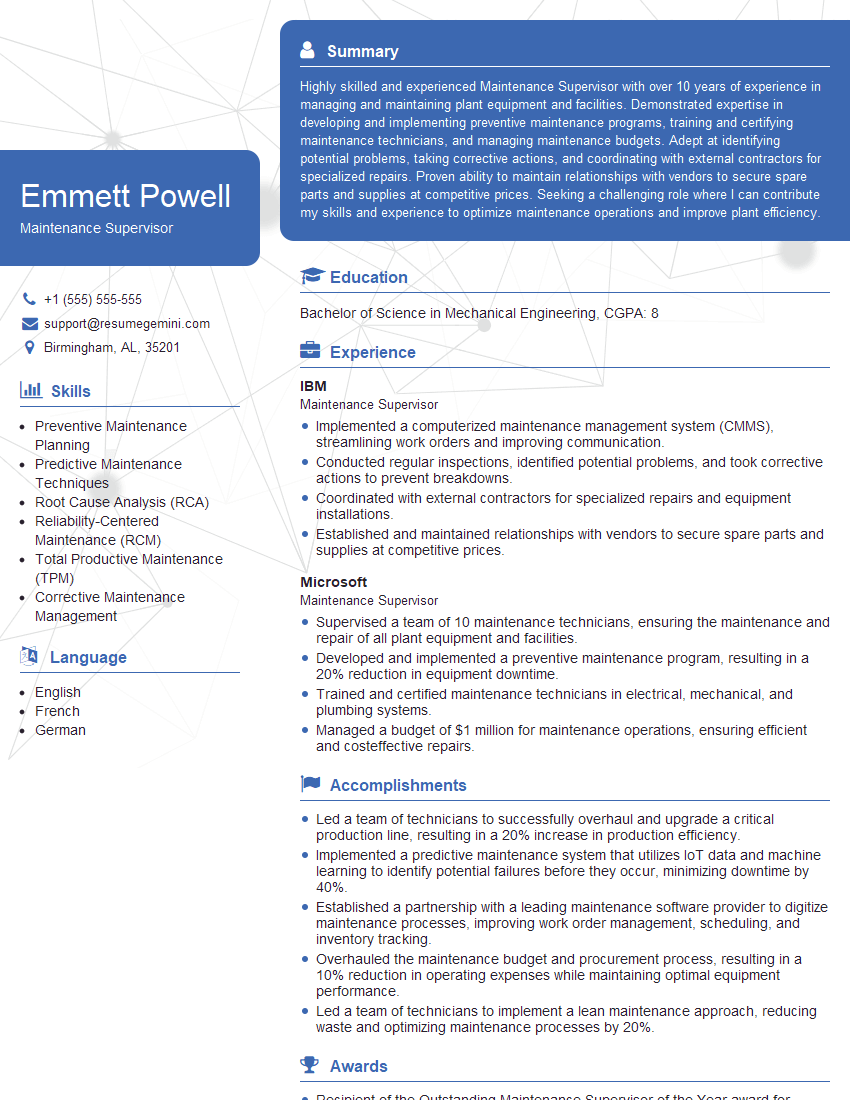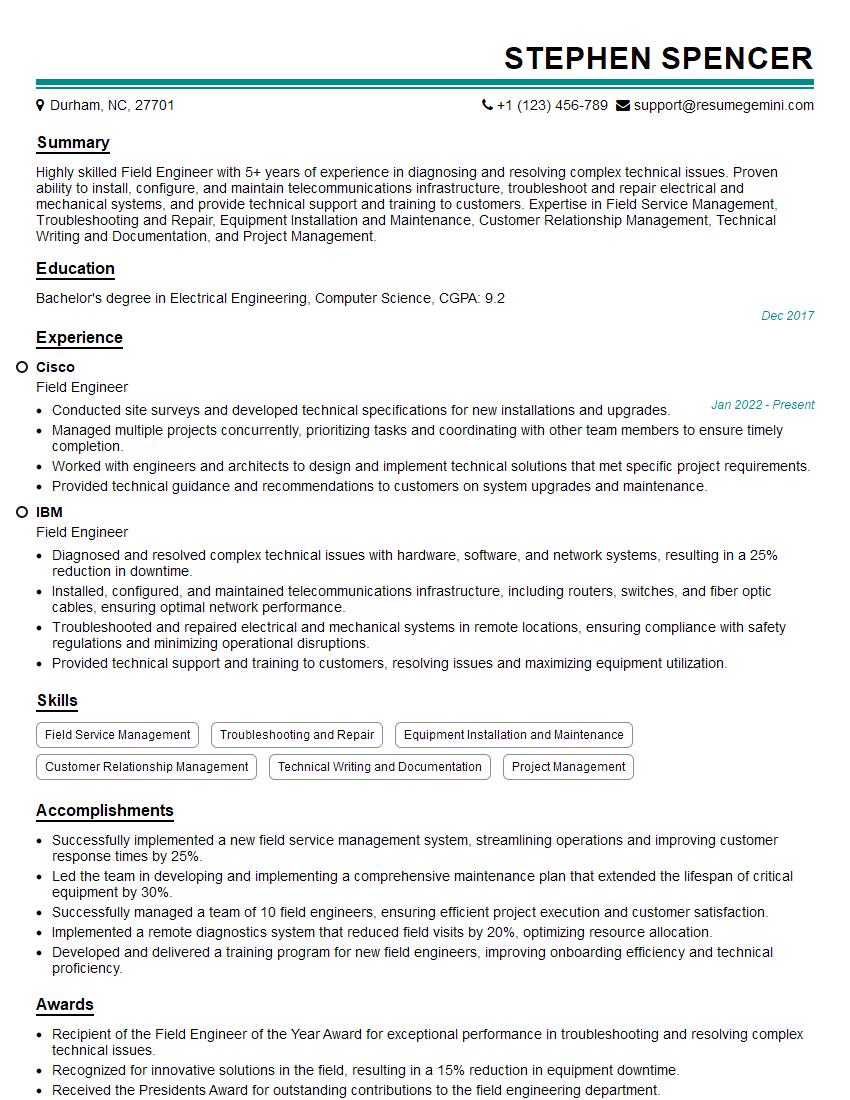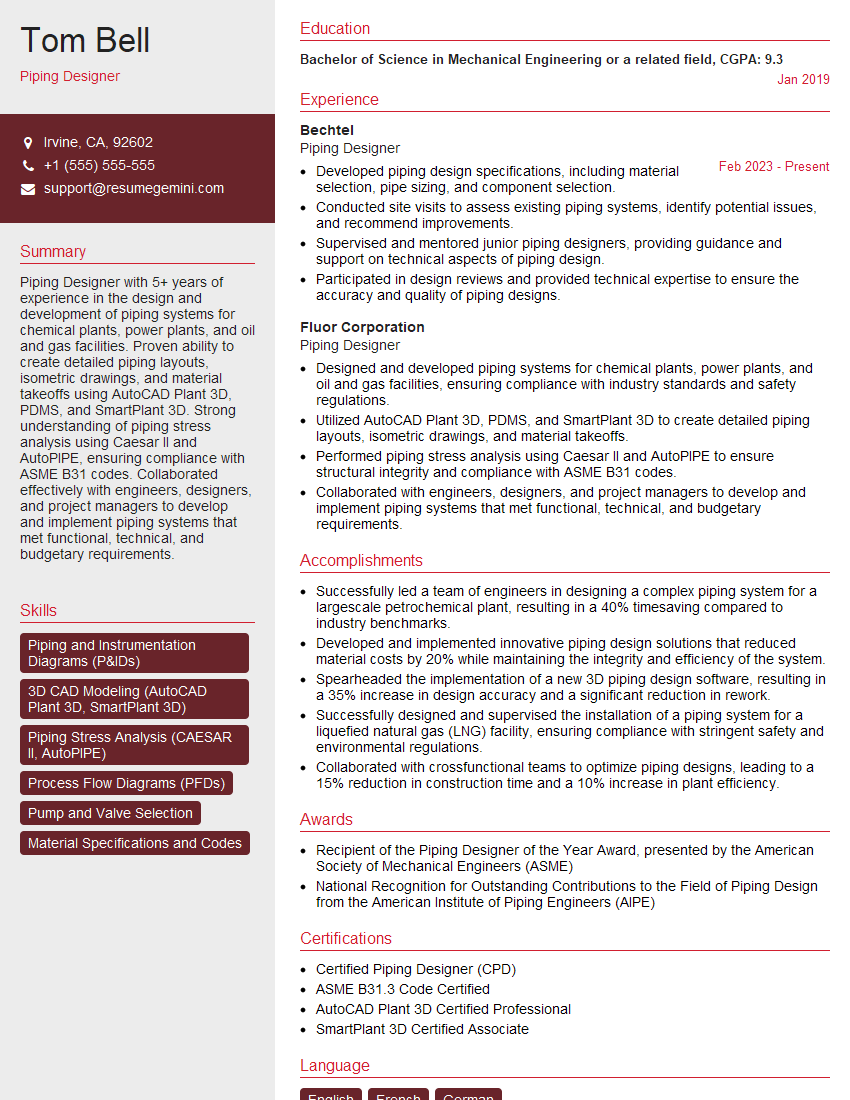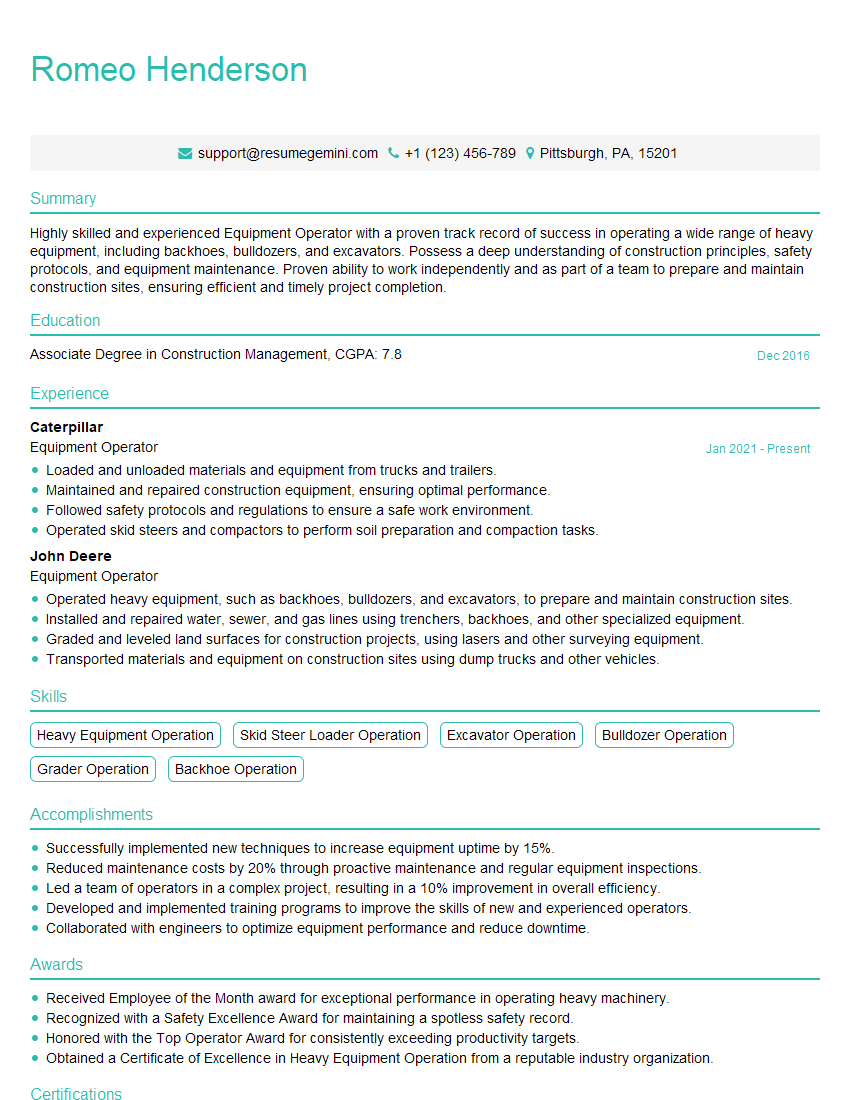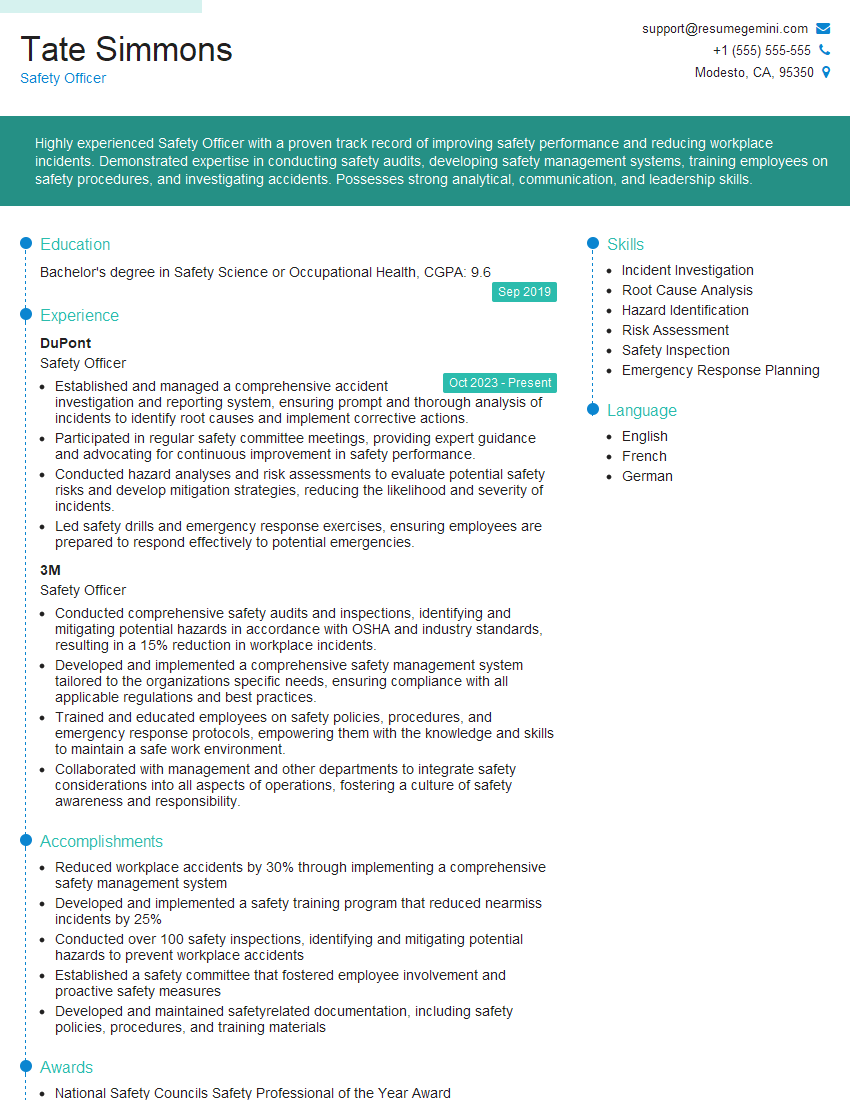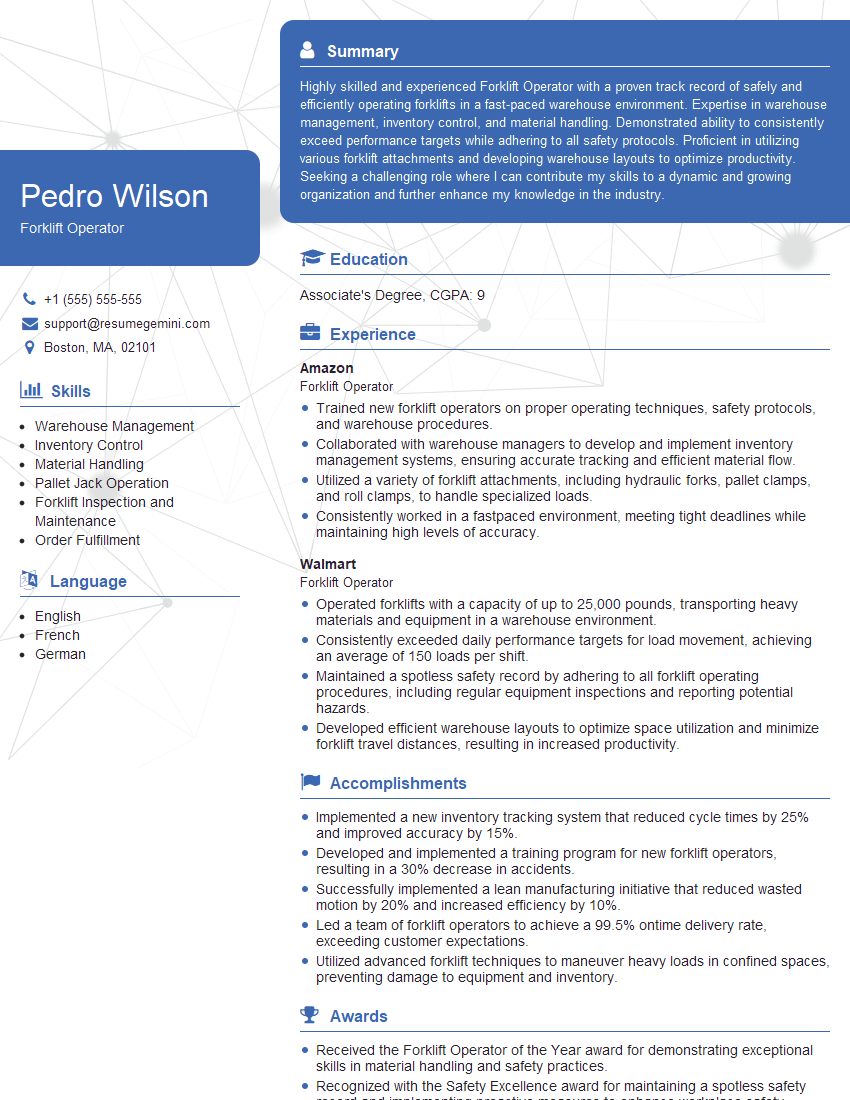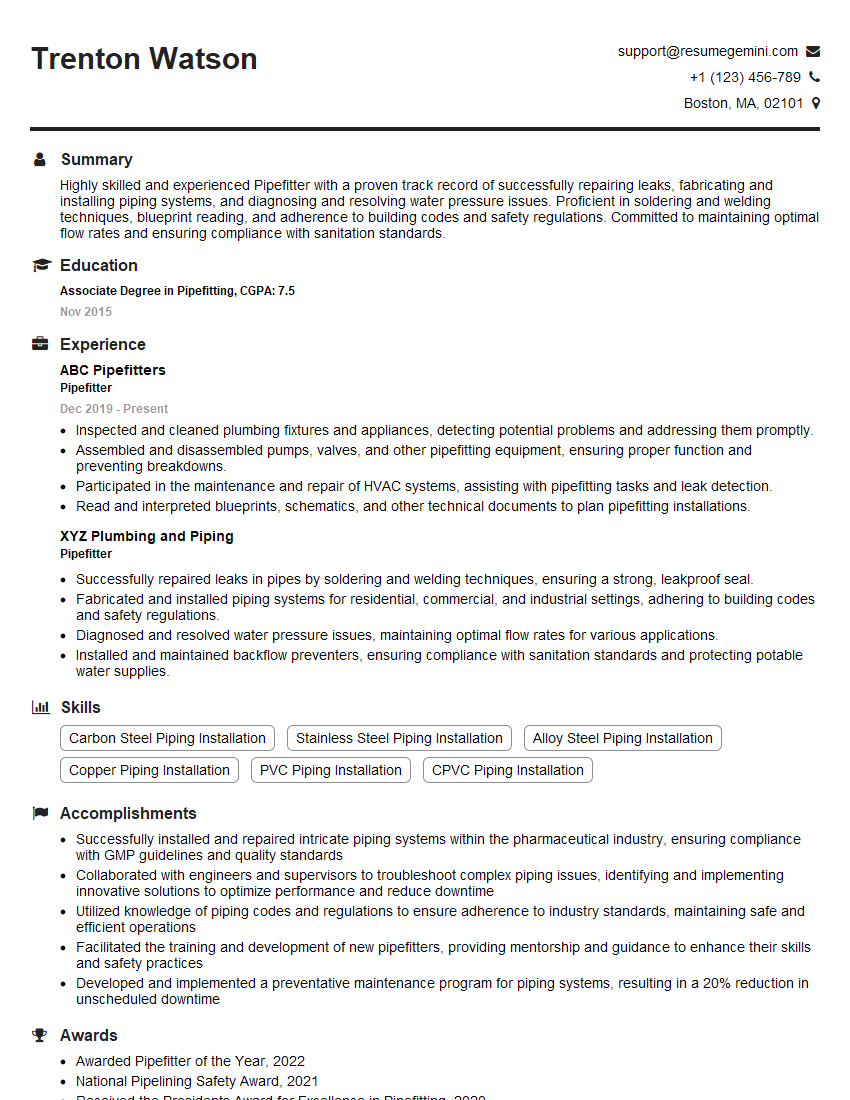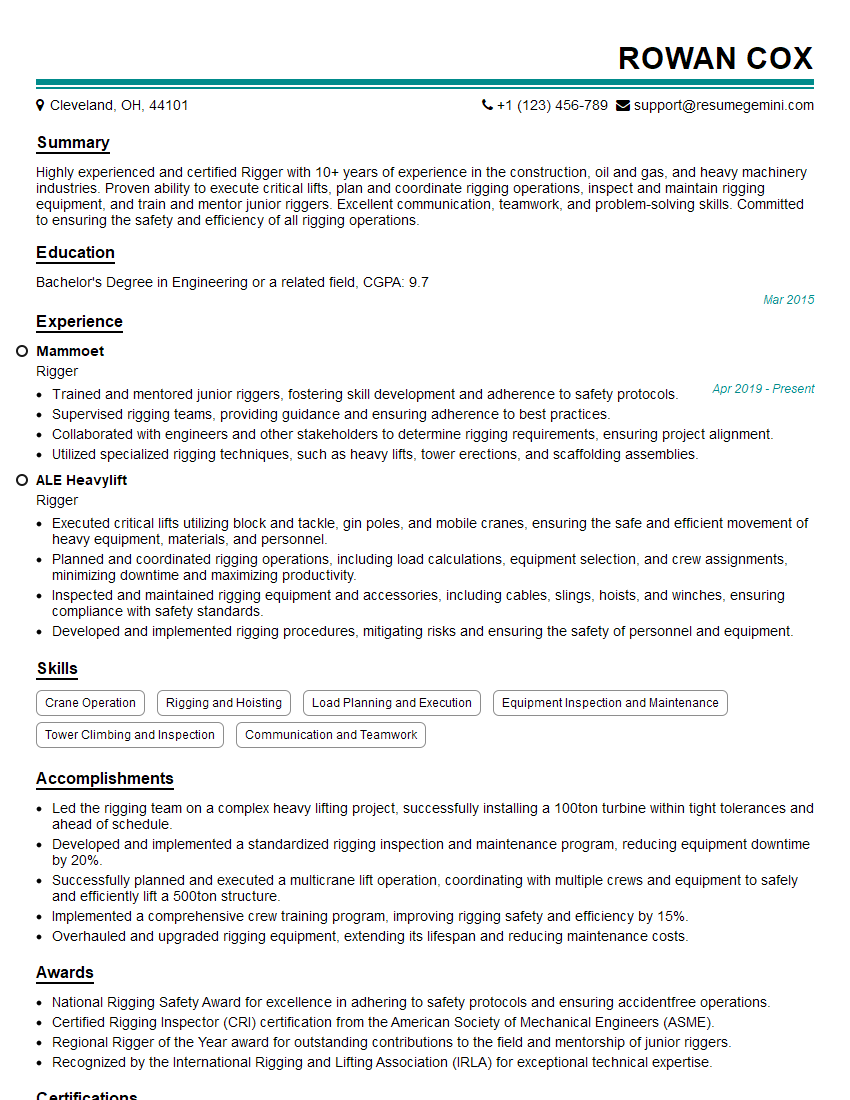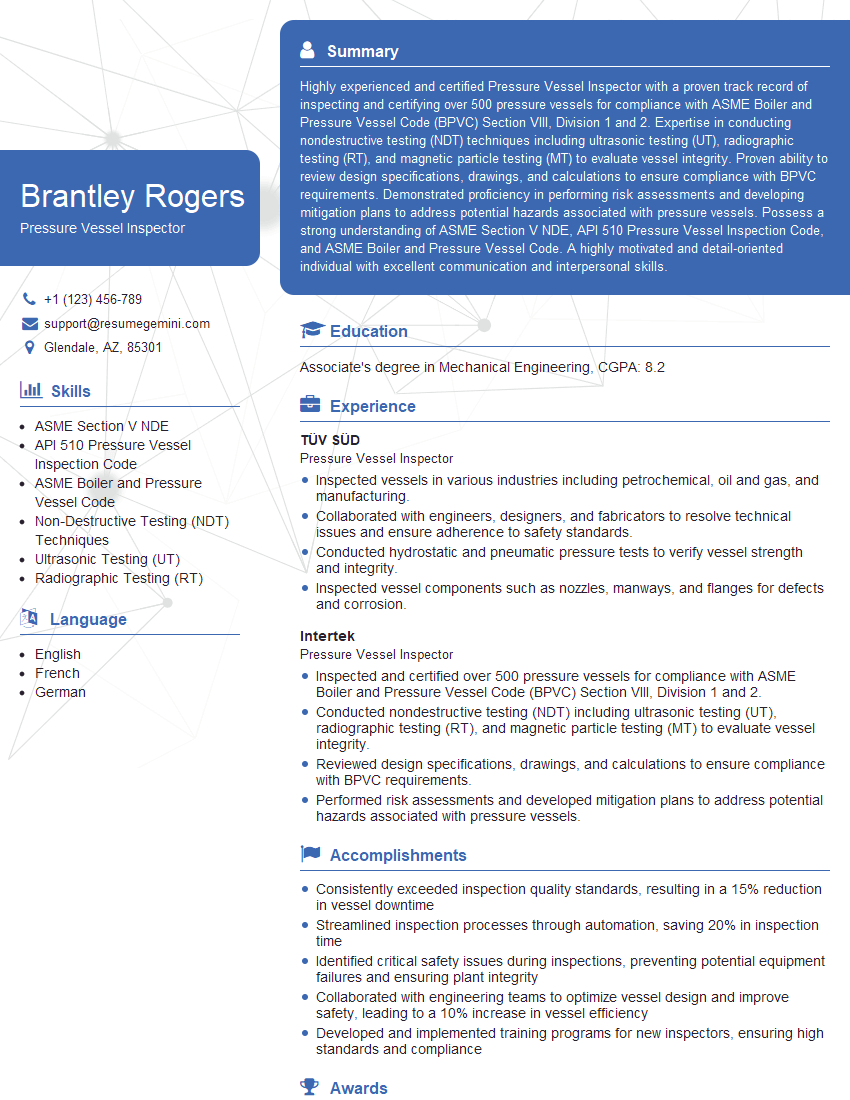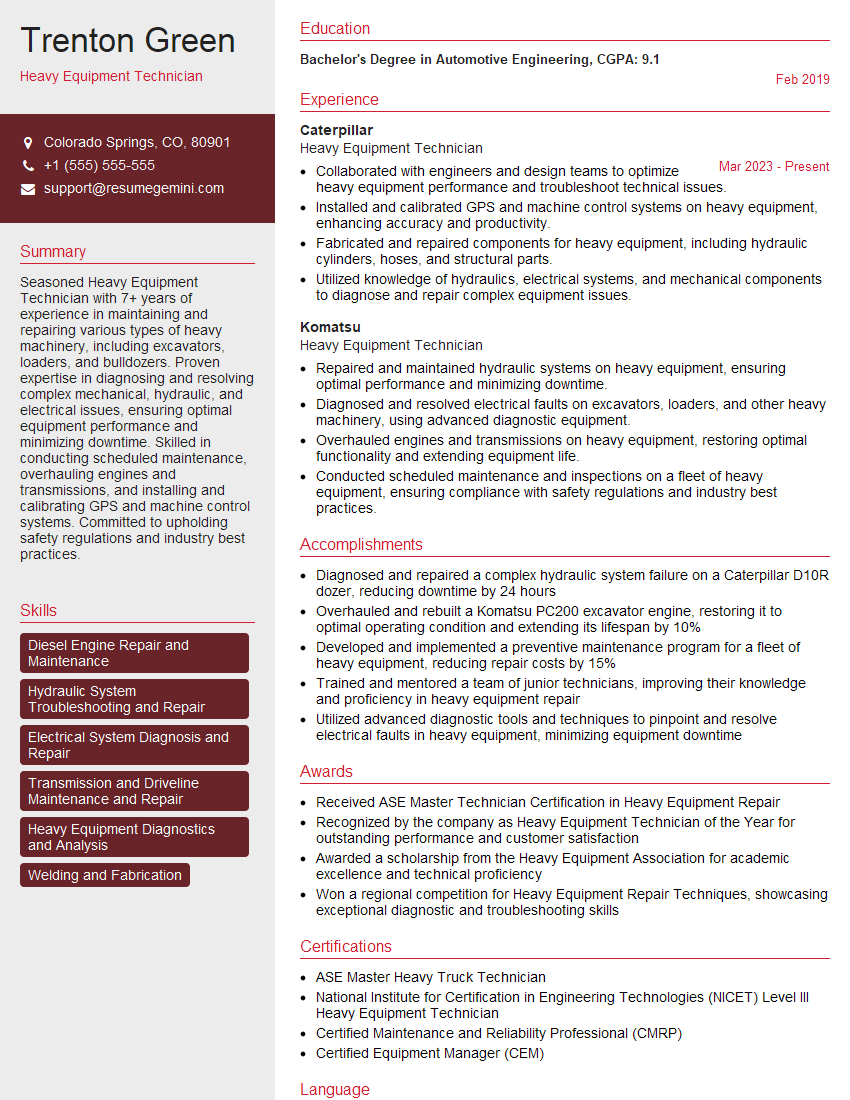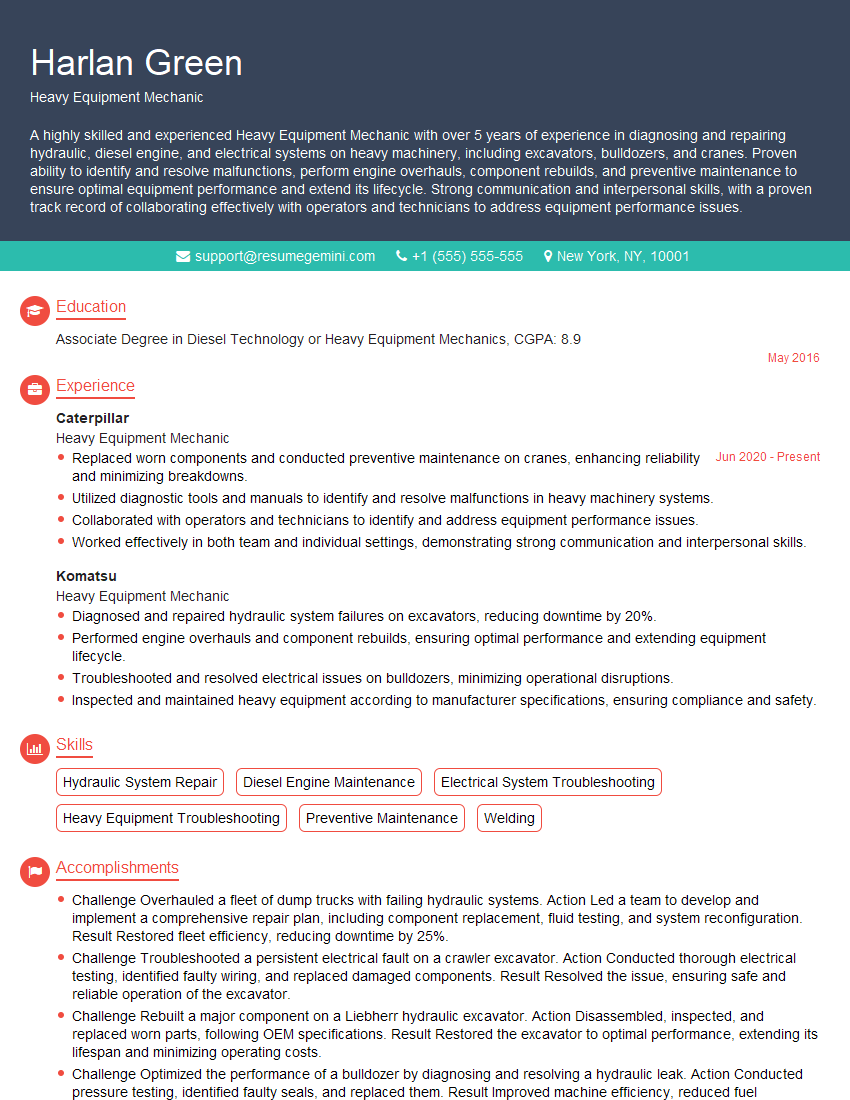Are you ready to stand out in your next interview? Understanding and preparing for Pipe and Equipment Handling interview questions is a game-changer. In this blog, we’ve compiled key questions and expert advice to help you showcase your skills with confidence and precision. Let’s get started on your journey to acing the interview.
Questions Asked in Pipe and Equipment Handling Interview
Q 1. Describe your experience with different types of pipe fittings and their applications.
Pipe fittings are crucial components that connect pipes, change direction, or alter flow characteristics. My experience encompasses a wide range, including:
- Elbows: Used to change the direction of a pipe run. I’ve worked with 45-degree and 90-degree elbows in various materials, selecting the appropriate type based on pressure, temperature, and fluid compatibility. For example, high-pressure applications often require forged steel elbows.
- Tees: Create branch lines, allowing for splitting or joining pipe flows. I’ve extensively used tees in both plumbing and industrial systems, making sure to consider the flow dynamics and potential for pressure drops.
- Reducers/Enlargers: Used to change the diameter of the pipe. Proper selection is critical to avoid excessive turbulence or flow restrictions. I’ve often encountered situations needing concentric and eccentric reducers to accommodate different pipe orientations.
- Unions: Allow for easy disassembly of a pipeline. These are essential for maintenance and repairs. I’ve specified unions based on material compatibility and pressure ratings, ensuring ease of access to critical sections.
- Flanges: Used for connecting larger diameter pipes. I have experience with various flange types, such as slip-on, weld neck, and blind flanges, choosing the most appropriate based on system pressures and safety requirements.
- Valves: These control and regulate the flow of fluids. My experience involves gate, globe, ball, and check valves, selecting each based on specific flow control needs and pressure ratings. For example, I’d typically avoid gate valves in situations where frequent throttling is required, opting instead for a globe valve.
Understanding the material compatibility (e.g., PVC for low-pressure water, carbon steel for high-pressure steam) and pressure ratings is key to selecting the correct fitting for each specific application.
Q 2. Explain the importance of proper pipe support and how to select appropriate methods.
Proper pipe support is paramount for preventing stress, vibration, and potential failure within a pipeline system. Insufficient support can lead to leaks, structural damage, and safety hazards. Selecting appropriate support methods involves considering several factors:
- Pipe Material and Diameter: Heavier pipes require more robust support.
- Fluid Properties: High-pressure or high-temperature fluids necessitate more frequent supports to mitigate stress.
- Environmental Conditions: Exposure to extreme temperatures or corrosive environments might necessitate specialized support materials.
- System Configuration: The layout and arrangement of the pipes influence the type and placement of supports.
Common support methods include:
- Hangers: Support pipes from above, often used for horizontal runs.
- Supports: Provide lateral support for vertical or horizontal pipes.
- Anchors: Secure pipes at specific points to prevent movement.
- Guides: Restrict pipe movement in a specific direction.
I follow industry standards and codes, such as ASME B31, when selecting and designing pipe supports, ensuring proper spacing and load distribution. For instance, in a large-diameter, high-pressure steam line, I’d utilize a combination of anchors, hangers, and guides to minimize vibration and thermal expansion effects. Improper support can lead to catastrophic failures, so meticulous planning is always crucial.
Q 3. What safety precautions are crucial when handling heavy equipment?
Safety is paramount when handling heavy equipment. I adhere to strict safety protocols, including:
- Lockout/Tagout Procedures: Before any maintenance or repair, ensuring equipment is properly de-energized and locked out to prevent accidental starts.
- Personal Protective Equipment (PPE): Always wearing appropriate safety gear, such as hard hats, safety glasses, steel-toe boots, and high-visibility clothing.
- Proper Lifting Techniques: Using lifting equipment correctly, ensuring the load is balanced and securely attached.
- Clear Communication: Maintaining clear communication between all personnel involved in the lift, using hand signals and designated spotters.
- Pre-lift Inspection: Carefully inspecting all equipment and rigging before each lift to ensure they are in safe working condition. This includes checking for damage, wear, and proper functionality.
- Restricted Areas: Establishing and enforcing restricted areas around heavy equipment to prevent unauthorized access.
- Emergency Procedures: Being aware of and prepared for emergencies, such as equipment malfunctions or accidents.
One instance where I personally intervened was noticing a crew member not wearing safety glasses during a rigging operation. Immediately, I stopped work and reinforced the importance of PPE, ultimately preventing a potential eye injury.
Q 4. How do you ensure the safe lifting and rigging of pipes and equipment?
Safe lifting and rigging requires meticulous planning and execution. Key steps include:
- Proper Assessment: Determining the weight and center of gravity of the pipe or equipment using appropriate tools and engineering calculations. Neglecting to do this precisely can lead to accidents.
- Selecting Appropriate Lifting Equipment: Choosing the right crane, slings, and other rigging hardware with sufficient capacity for the load. Using equipment rated below the needed capacity is a significant safety risk.
- Rigging Plan: Developing a detailed rigging plan that outlines the lifting procedure, including the type and placement of slings, attachments, and personnel responsibilities.
- Pre-lift Inspection: Thoroughly inspecting all rigging equipment, ensuring it is free from damage, properly secured, and rated for the load.
- Controlled Lift: Executing the lift slowly and smoothly, maintaining constant communication between the crane operator and ground crew. Sudden movements or jerky lifting can result in swings and accidents.
- Safe Landing Zone: Identifying and clearing a safe landing zone that is free from obstructions.
For example, when lifting a long section of pipe, we often use multiple slings to distribute the load evenly and prevent stress on any single point. Using spreader beams is also a critical component for maintaining balance and minimizing potential for pipe deformation during handling.
Q 5. Describe your experience with different types of cranes and their capabilities.
My experience includes working with various crane types, each suited for different tasks:
- Overhead Cranes: Used in workshops and fabrication yards for lifting and moving materials within a confined area. These are very common in our industry.
- Mobile Cranes (Truck-Mounted, Crawler, etc.): Highly versatile, used for various lifting tasks in open areas. I have experience selecting the appropriate type based on weight capacity, reach, and ground conditions. For example, a crawler crane is preferred for uneven ground.
- Tower Cranes: Used in large construction projects for lifting heavy loads over significant heights. They are integral for large-scale projects.
- Floating Cranes: Used for lifting and installing equipment on water or in marine environments.
I understand the limitations and capabilities of each crane type, ensuring the chosen crane is adequately rated for the job, considering factors like load capacity, reach, and stability. Misjudgment in crane selection can lead to severe accidents.
Q 6. Explain the process of pre-job planning for pipe and equipment handling.
Pre-job planning for pipe and equipment handling is crucial to ensure safety and efficiency. The process typically involves:
- Risk Assessment: Identifying potential hazards and developing mitigation strategies. This includes assessing environmental conditions, equipment capabilities, and personnel qualifications.
- Equipment Selection: Choosing appropriate cranes, lifting gear, and other equipment based on the size, weight, and characteristics of the pipes and equipment.
- Site Survey: Evaluating the work site, including access routes, ground conditions, and potential obstructions. This helps determine the lift path and feasibility of the operation.
- Lifting Plan: Developing a detailed lifting plan that includes the sequence of operations, personnel assignments, communication protocols, and emergency procedures.
- Method Statement: Creating a comprehensive document outlining the complete procedure with safety measures, contingency plans, and adherence to regulations. A well-written method statement acts as a roadmap for the entire operation.
- Training and Communication: Ensuring that all personnel involved are properly trained, understand their roles and responsibilities, and know the emergency procedures.
A thorough pre-job planning phase is pivotal for safety, as unforeseen circumstances during the operation can be mitigated proactively. A poorly planned operation can result in equipment damage and, critically, injuries.
Q 7. How do you handle unexpected issues or equipment malfunctions during operation?
Handling unexpected issues requires a calm, methodical approach. My response includes:
- Immediate Assessment: Quickly and safely assess the situation, determining the nature of the problem and its potential impact.
- Communication: Immediately communicate with relevant personnel, including supervisors and safety officers, informing them of the situation.
- Problem Solving: Based on the assessment, develop a solution, carefully considering safety implications. This could involve using alternative equipment, adjusting the lifting plan, or temporarily halting operations.
- Troubleshooting: If the problem involves equipment malfunction, attempt to troubleshoot the issue according to the manufacturer’s instructions. However, always prioritize safety – if unsure, call for qualified technical support.
- Documentation: Meticulously document the incident, including the cause, steps taken to resolve it, and any corrective actions needed. This is vital for future planning and improving safety protocols.
I once encountered a sudden power outage during a critical lift. Immediately, I communicated the situation and ensured all personnel were clear of the affected equipment. We developed a backup plan using a standby generator, and the operation was completed safely, demonstrating a practical response to unexpected challenges.
Q 8. What are the common causes of pipe leaks and how do you address them?
Pipe leaks are a significant concern in any piping system, leading to costly repairs, environmental damage, and safety hazards. Common causes are multifaceted, ranging from material degradation to improper installation.
- Corrosion: This is particularly prevalent in metallic pipes, especially in environments with aggressive chemicals or fluctuating temperatures. For example, steel pipes exposed to saltwater can corrode rapidly, leading to pinhole leaks. Addressing this involves using corrosion-resistant materials like stainless steel or applying protective coatings.
- External Damage: Physical impacts, ground movement, or rodent activity can cause cracks or punctures. Regular inspections and protective measures like pipe sleeving are crucial. I once encountered a leak caused by a tree root penetrating a PVC pipe; timely detection prevented a major disruption.
- Internal Corrosion: This occurs due to the chemical nature of the transported fluid. For instance, acidic fluids can erode pipe walls over time. Material selection, lining the pipes, or using inhibitors is essential.
- Improper Installation: Incorrect jointing, insufficient support, or poor welding can create stress points leading to leaks. Meticulous adherence to installation standards and proper training for personnel are paramount.
- Manufacturing Defects: Faulty pipes can exhibit weaknesses from the start. This underscores the need for thorough quality checks at every stage, from manufacturing to installation.
Addressing leaks involves identifying the root cause, isolating the affected section, performing the necessary repair (welding, patching, joint replacement), and pressure testing to ensure integrity. The specific solution will depend heavily on the pipe material, the severity of the damage, and the operating environment.
Q 9. Describe your experience with different pipe materials (steel, PVC, etc.) and their properties.
My experience encompasses a wide range of pipe materials, each with distinct properties impacting their suitability for various applications.
- Steel: High strength and durability make steel suitable for high-pressure applications. However, it’s susceptible to corrosion and requires protective measures in certain environments. I’ve worked extensively with carbon steel and stainless steel pipes in industrial settings, choosing between them based on the corrosive nature of the transported fluid and the operating temperature.
- PVC (Polyvinyl Chloride): PVC is lightweight, corrosion-resistant, and cost-effective, making it ideal for lower-pressure applications and chemical handling. I’ve used PVC extensively in water distribution systems where its resistance to chemical attack is beneficial. However, its lower strength limits its suitability for high-pressure scenarios.
- Cast Iron: Historically common but increasingly less prevalent due to its brittle nature and susceptibility to corrosion. It offers good pressure resistance in specific situations.
- Ductile Iron: An improvement over cast iron, offering greater ductility and higher strength. It’s commonly used in water distribution and wastewater systems.
- Copper: Excellent corrosion resistance and ductility, making it suitable for potable water systems and other applications requiring clean and reliable conveyance. Its high cost may limit its usage in large-scale projects.
Material selection is crucial, depending on factors like pressure rating, temperature fluctuations, chemical compatibility, and environmental conditions. A thorough understanding of each material’s properties is essential for successful project execution.
Q 10. Explain the procedures for inspecting and testing pipes before and after installation.
Pipe inspection and testing are critical stages, ensuring system integrity and preventing future issues. Procedures differ depending on the pipe material and application but generally follow these steps:
- Pre-Installation Inspection: This involves visually inspecting pipes for any defects like cracks, dents, or corrosion before installation. Dimensional checks are performed to ensure conformity with specifications. This stage includes verifying material certifications to ensure they meet required standards.
- Hydrostatic Testing: After installation and before commissioning, hydrostatic testing is done to verify the system’s pressure capability. The pipe is filled with water, pressurized to a specified level above the working pressure, and held for a specific duration to detect leaks or weaknesses. Any leakage is noted, repaired and the test is repeated.
- Non-Destructive Testing (NDT): Methods such as radiography, ultrasonic testing, or magnetic particle inspection are employed to detect internal or surface flaws in the pipe material without causing damage. This is particularly valuable in high-pressure systems where failure can have severe consequences.
- Visual Inspection Post-Installation: A final visual check is conducted after installation to confirm correct alignment, support, and overall system integrity. I’ve personally used this method before commissioning a newly installed section of pipe in an offshore oil and gas platform.
Detailed records are kept of all inspections and tests, forming a critical part of the project documentation and contributing significantly to future maintenance and repair planning. Proper documentation is as vital as the testing itself.
Q 11. How do you ensure compliance with safety regulations and industry standards?
Compliance is paramount in pipe and equipment handling. Safety regulations and industry standards – such as those from OSHA, ASME, and API – guide all our operations.
- Risk Assessments: We conduct thorough risk assessments before initiating any work, identifying potential hazards and implementing appropriate control measures. This includes the use of personal protective equipment (PPE), confined space entry procedures, and safe lifting practices.
- Training and Certifications: All personnel involved receive comprehensive training on safety regulations, safe handling procedures, and the use of specialized equipment. Certifications such as those for crane operation or welding are mandatory for personnel handling specific tasks. I personally ensure everyone on my team maintains updated certifications and is fully informed about all safety procedures.
- Permit-to-Work Systems: These formal systems ensure that all necessary safety precautions are in place before commencing high-risk activities such as hot work or working at heights. This rigorous system has prevented several potential accidents in my career.
- Regular Audits and Inspections: Regular safety audits and inspections are performed to ensure continued compliance with regulations and the effectiveness of implemented safety measures. Findings are documented, and corrective actions are promptly implemented.
A culture of safety is ingrained in our operations. It’s not merely compliance; it’s a proactive approach that prioritizes the well-being of our personnel and the integrity of our operations.
Q 12. Describe your experience with hydraulic systems used in pipe handling equipment.
Hydraulic systems are integral to many pipe handling equipment, providing the power for lifting, rotating, and maneuvering heavy pipes. My experience includes working with various hydraulic systems in cranes, pipe bending machines, and other specialized equipment.
- Hydraulic Cylinders: These convert hydraulic pressure into linear motion, crucial for lifting and clamping pipes. I’ve worked with double-acting cylinders for lifting and single-acting cylinders for clamping functions.
- Hydraulic Pumps: These provide the necessary hydraulic flow and pressure to operate the cylinders and other hydraulic components. Different pump types are chosen based on flow rate, pressure requirements, and power source. I’ve overseen maintenance and repairs on several types of hydraulic pumps.
- Hydraulic Valves: These control the flow of hydraulic fluid, directing it to different parts of the system. Directional control valves, pressure relief valves, and flow control valves are essential components. Diagnosing and troubleshooting valve malfunctions is a critical part of maintaining hydraulic equipment.
- Hydraulic Fluids: Selecting the correct hydraulic fluid is crucial, considering factors like operating temperature, compatibility with seals, and environmental concerns. I’ve worked with different types of hydraulic fluids, ensuring compatibility with the system and adherence to environmental regulations.
Understanding hydraulic systems is vital for effective operation and maintenance of pipe-handling equipment, enabling safe and efficient handling of heavy pipes.
Q 13. What are the common types of pipe joints and their strengths and weaknesses?
Several types of pipe joints are used depending on the application, each with its own strengths and weaknesses.
- Threaded Joints: Relatively simple and economical for smaller diameter pipes. However, they can be prone to leakage if not properly sealed and are less suitable for high-pressure applications.
- Flanged Joints: Strong, reusable, and suitable for high-pressure applications. They require more space and can be more expensive than other options. Gaskets are used to create a leak-proof seal between flanges.
- Welded Joints: Provide excellent strength and leak tightness but require specialized skills and equipment. Different welding techniques are employed depending on the pipe material. Inspecting welds for defects is critical to ensure integrity.
- Compression Joints: Relatively easy to install and disassemble, often used in low-pressure applications with plastic pipes. They rely on compression fittings to create a seal and may be less suitable for high-temperature or high-pressure applications.
- Butt Fusion Joints: Used for thermoplastic pipes, offering a strong and leak-tight connection. They require specialized equipment for heating and fusing the pipe ends.
Joint selection must consider factors such as pipe material, pressure rating, temperature, ease of installation, cost, and the need for reusability. A proper understanding of each joint type is crucial for selecting the most suitable option for a given application.
Q 14. How do you calculate the required lifting capacity for different pipe sizes and weights?
Calculating the required lifting capacity involves considering several factors to ensure safe and efficient pipe handling.
The basic calculation involves considering the weight of the pipe itself, along with any additional weight from fittings or attached equipment. The pipe’s weight can be calculated using its length, diameter, and material density:
Weight = Length x π x (Diameter/2)² x DensityFor example, let’s say we have a 10-meter long steel pipe with a diameter of 0.5 meters and a density of 7850 kg/m³. The weight would be approximately 7696 kg.
However, this is just the starting point. We also need to consider:
- Safety Factor: A safety factor is always added to account for unexpected events or variations in the pipe weight. A common safety factor is 1.5 to 2.0, meaning the lifting capacity should be 1.5 to 2 times the calculated weight.
- Lifting Angle: The lifting angle affects the load on the lifting mechanism. Lifting at an angle increases the load, requiring a higher lifting capacity.
- Dynamic Loads: Sudden movements or oscillations during lifting can create dynamic loads that increase the stress on the lifting mechanism.
- Environmental Conditions: Factors like wind and temperature can affect the required lifting capacity.
Therefore, a comprehensive calculation requires considering all these factors. Software tools or engineering calculations are often used for more complex scenarios to ensure safety and prevent equipment failures. The calculated lifting capacity should always exceed the maximum expected load.
Q 15. What are the different types of pipe welding techniques and their applications?
Pipe welding is a crucial aspect of pipe handling, and several techniques exist, each suited to specific applications. The choice depends on factors like pipe material, diameter, wall thickness, and the desired weld quality.
- Shielded Metal Arc Welding (SMAW): Also known as stick welding, this is a versatile and relatively inexpensive method suitable for various pipe materials and diameters. It’s robust and works well in outdoor environments but requires skilled operators to achieve consistent weld quality. Example: Repairing a small diameter carbon steel pipe in a field setting.
- Gas Metal Arc Welding (GMAW): Also known as MIG welding, this method uses a continuous wire feed, resulting in faster welding speeds compared to SMAW. It produces high-quality welds and is ideal for thicker pipes and production environments. Example: Manufacturing a large-diameter stainless steel pipeline for a chemical plant.
- Gas Tungsten Arc Welding (GTAW): Also known as TIG welding, this process offers excellent control and produces the highest quality welds, often used for critical applications where precision and cleanliness are paramount. It’s slower than GMAW but yields superior results. Example: Welding thin-walled high-pressure pipes in a nuclear power plant.
- Submerged Arc Welding (SAW): This high-productivity method is used for large-diameter pipes, often in automated settings. A flux blanket covers the weld, protecting it from atmospheric contamination and producing deep penetration welds. Example: Manufacturing long-seam welds in large-diameter pipelines.
The selection of a welding technique is always a critical decision and involves careful consideration of factors like cost, speed, weld quality requirements, and the environment where the welding will be performed.
Career Expert Tips:
- Ace those interviews! Prepare effectively by reviewing the Top 50 Most Common Interview Questions on ResumeGemini.
- Navigate your job search with confidence! Explore a wide range of Career Tips on ResumeGemini. Learn about common challenges and recommendations to overcome them.
- Craft the perfect resume! Master the Art of Resume Writing with ResumeGemini’s guide. Showcase your unique qualifications and achievements effectively.
- Don’t miss out on holiday savings! Build your dream resume with ResumeGemini’s ATS optimized templates.
Q 16. How do you interpret piping and instrumentation diagrams (P&IDs)?
Piping and Instrumentation Diagrams (P&IDs) are schematic drawings that show the flow of fluids, instruments, and equipment in a process system. Interpreting them requires understanding the symbols and conventions used. Think of it like reading a map for a process plant.
To interpret a P&ID, I would follow these steps:
- Identify the process: Understand the overall purpose of the system depicted.
- Analyze the flow: Trace the flow of fluids (liquids, gases, etc.) through the piping system, noting the direction and any changes in pressure or temperature.
- Identify equipment: Recognize the various components, like pumps, valves, heat exchangers, and vessels, understanding their function within the system.
- Understand instrumentation: Identify instruments used for measurement and control (e.g., pressure gauges, temperature sensors, flow meters, control valves). Note their location and purpose.
- Examine the line designations: These typically indicate pipe size, material, and other important characteristics.
- Check for safety devices: Locate safety relief valves, emergency shut-off valves, and other crucial safety components.
Effective P&ID interpretation is essential for ensuring the safe and efficient operation of any process system. Misinterpretation can lead to operational problems, safety hazards, and costly downtime.
Q 17. Explain the process of pressure testing pipes and equipment.
Pressure testing is a critical step to ensure the integrity of pipes and equipment before they are put into service. It involves filling the system with a pressurized fluid (usually water or air) and monitoring for leaks or other signs of weakness. The process is crucial for safety and reliability.
The process typically involves these steps:
- System preparation: Ensure all valves are properly closed or open as required. Blind flanges may be used to isolate sections of the system.
- Pressure medium selection: Choose the appropriate pressure medium (water or air) based on system requirements and safety considerations. Water is often preferred as it’s less prone to causing damage in case of a leak.
- Pressurization: Gradually increase the pressure to the specified test pressure. This should be done slowly and monitored carefully.
- Leak detection: Visually inspect the entire system for any leaks. Specialized leak detection equipment (e.g., ultrasonic leak detectors) may also be used.
- Pressure holding: Maintain the test pressure for a specified duration to verify that the system can withstand the pressure without significant pressure drop.
- Pressure release: Slowly release the pressure after the test is complete.
- Documentation: Record all aspects of the test, including pressure readings, duration, and any observed leaks or abnormalities.
The test pressure is typically higher than the operating pressure to provide a safety margin and ensure the system can handle expected pressures and surges.
Q 18. What are the common causes of equipment failure in pipe handling operations?
Equipment failure in pipe handling operations can stem from various sources, often interconnected. Understanding these causes is essential for preventative maintenance and safety.
- Corrosion: Chemical reactions degrade pipe materials over time, weakening them and leading to leaks or ruptures. This is particularly problematic in environments with corrosive fluids or high humidity.
- Erosion: The constant flow of fluids, especially abrasive materials, can erode the inner surface of pipes, reducing their wall thickness and causing failure.
- Fatigue: Repeated cycles of stress and strain can cause metal fatigue, leading to cracks and eventual failure. This is often seen in systems subject to vibration or pressure fluctuations.
- Improper installation: Mistakes during installation, such as poor welding, incorrect pipe support, or insufficient insulation, can lead to premature failure.
- Overpressure: Exceeding the design pressure of pipes or equipment can cause immediate failure. Safety relief valves are crucial to prevent this.
- External damage: Physical impacts, ground movement, or vandalism can damage pipes and equipment.
- Lack of maintenance: Regular inspection and maintenance are vital to prevent issues from escalating into major failures. This includes regular cleaning, inspections, and repairs.
A proactive approach involving regular inspections, preventative maintenance, and adherence to safety protocols is crucial to minimize equipment failures and ensure the safe and efficient operation of pipe handling systems.
Q 19. Describe your experience with troubleshooting and repairing heavy equipment.
Throughout my career, I’ve extensively dealt with troubleshooting and repairing heavy equipment. My approach is systematic and focuses on safety first. I’ve encountered various challenges, from hydraulic system leaks on excavators to electrical faults in cranes. One memorable instance involved a malfunctioning crawler crane on a pipeline construction site.
The crane experienced intermittent engine stalling. My troubleshooting involved a step-by-step process:
- Safety assessment: Securing the area and ensuring no one was in danger before commencing any work.
- Data gathering: Collecting information about the problem, including the frequency, duration, and any preceding events.
- Visual inspection: Carefully examining the engine compartment, fuel lines, and electrical wiring for any visible damage or leaks.
- Diagnostic testing: Utilizing diagnostic tools to assess engine performance, fuel delivery, and electrical systems.
- Component replacement/repair: Based on the diagnosis, I identified a faulty fuel injector. After its replacement, the crane functioned correctly.
- Testing and verification: Running comprehensive tests to confirm the repair’s success before releasing the crane back into service.
This methodical approach has allowed me to resolve complex equipment issues efficiently and safely, minimizing downtime and ensuring the continued operation of critical equipment.
Q 20. How do you manage and maintain inventory of pipe and equipment?
Effective pipe and equipment inventory management is essential for smooth operations and cost control. I typically employ a combination of methods to maintain accurate and up-to-date records.
- Database management: Using a computerized database system (e.g., ERP software) to track pipe materials (type, size, quantity, location), equipment (model, serial number, maintenance history), and their respective locations.
- Barcoding/RFID: Utilizing barcodes or RFID tags to identify and track individual pipes or equipment, enhancing inventory accuracy and simplifying tracking.
- Regular stock taking: Conducting regular physical inventory checks to verify database accuracy and identify any discrepancies.
- First-in, First-out (FIFO): Implementing a FIFO system for consumable materials to ensure that older items are used first, reducing the risk of spoilage or obsolescence.
- Predictive maintenance scheduling: Using historical data and equipment performance to schedule maintenance, reducing downtime and extending equipment lifespan.
These practices ensure accurate inventory counts, minimize waste, optimize procurement, and reduce the risk of unexpected delays due to missing materials or faulty equipment.
Q 21. What are the best practices for storing and handling different pipe materials?
Proper storage and handling of different pipe materials are critical for preventing damage, corrosion, and ensuring their longevity. The approach differs depending on the material.
- Steel pipes: Should be stored off the ground, ideally on racks, to prevent corrosion from moisture. Coatings or protective wraps should be maintained to prevent rust. Avoid stacking pipes too high to prevent damage.
- Plastic pipes (PVC, HDPE): These are relatively durable but should be protected from UV radiation (sunlight), which can degrade their properties. Store them in a shaded area or use UV-resistant covers.
- Copper pipes: Relatively resistant to corrosion, but contact with other metals can lead to galvanic corrosion. Store them separately from other metals and protect them from physical damage.
- Cast iron pipes: Susceptible to corrosion, particularly in damp environments. Store them off the ground, in a dry location, and use protective coatings.
General best practices include clear labeling of pipe materials and sizes, maintaining appropriate spacing to allow for easy access and preventing damage during handling, and using proper lifting equipment for heavy pipes.
Adherence to these guidelines helps to preserve the quality and integrity of the pipe materials and ensure their safe and effective use in projects.
Q 22. Explain the importance of regular maintenance and inspection of pipe and equipment.
Regular maintenance and inspection of pipes and equipment are paramount for ensuring operational efficiency, safety, and longevity. Neglecting these crucial aspects can lead to costly repairs, production downtime, environmental hazards, and even catastrophic failures. Think of it like a car – regular oil changes and check-ups prevent major breakdowns down the line.
- Preventative Maintenance: This involves scheduled inspections, cleaning, lubrication, and minor repairs to prevent larger issues from developing. For instance, regularly checking for corrosion on pipelines can prevent leaks and structural damage.
- Predictive Maintenance: This utilizes advanced technologies like vibration analysis and thermal imaging to identify potential problems before they manifest physically. This allows for proactive intervention and minimizes disruptions.
- Corrective Maintenance: This addresses issues that have already occurred. While necessary, it’s more costly and disruptive than preventative or predictive maintenance. A sudden pipe burst, for instance, necessitates immediate corrective action.
A comprehensive maintenance program includes detailed records of inspections, repairs, and replacements, enabling better planning and resource allocation. This data-driven approach allows for optimized maintenance schedules and better prediction of equipment lifespan.
Q 23. Describe your experience with different types of pipe hangers and supports.
My experience encompasses a wide range of pipe hangers and supports, each selected based on factors such as pipe size, material, operating temperature, and the surrounding environment. I’ve worked with:
- Rigid Hangers: These provide fixed support and are suitable for applications where minimal movement is desired. I’ve used them extensively in high-pressure steam lines where stability is critical.
- Spring Hangers: These compensate for thermal expansion and contraction, preventing excessive stress on the piping system. In a project involving a large chemical processing plant, spring hangers were essential to accommodate the significant temperature fluctuations.
- Constant Support Hangers: These maintain a consistent load on the pipe regardless of its movement. Their application is frequent in situations where vibration damping is crucial, such as in sensitive instrumentation lines.
- Trapeze Hangers: These offer multiple support points, enhancing stability and load distribution. I implemented these in a long-span pipeline project where uniform support was crucial.
- Hydraulic and Pneumatic Snubbers: These damp vibrations and limit movement during seismic events or pressure surges. These are crucial in safety-critical applications such as nuclear power plants.
Selecting the appropriate hanger requires careful consideration of all the factors I mentioned. Incorrect selection can lead to premature failure of the pipe and its supports, causing significant disruptions and safety concerns.
Q 24. How do you ensure proper alignment of pipes during installation?
Proper pipe alignment is crucial for ensuring smooth fluid flow, preventing stress concentrations, and avoiding premature failure. Deviation from the design specifications can lead to leaks, vibrations, and even catastrophic ruptures.
My approach involves a multi-step process:
- Layout and Planning: Precise planning based on detailed engineering drawings is essential. This includes considering all potential obstacles and constraints.
- Reference Points: Establishing accurate reference points along the pipeline using laser levels and other surveying equipment ensures precise alignment.
- Temporary Supports: Strategic placement of temporary supports maintains the alignment during installation. These are removed only after the permanent hangers are secured.
- Alignment Tools: Employing alignment tools like laser levels, plumb bobs, and transits ensures accuracy. Checking alignment at every stage using these tools is mandatory.
- Verification: After installation, a final alignment check is critical to verify that the pipe is within the specified tolerances.
Throughout the process, meticulous attention to detail and rigorous quality control measures are paramount to ensure accurate alignment and successful installation.
Q 25. What are the environmental considerations when handling pipes and equipment?
Environmental considerations are pivotal in pipe and equipment handling. Ignoring them can lead to significant environmental damage and regulatory non-compliance.
- Spill Prevention: Implementing measures to prevent spills of hazardous materials is critical. This includes using proper containment systems and emergency response plans.
- Erosion and Sediment Control: Construction activities can cause soil erosion. Employing erosion control measures, such as silt fences, is important to protect waterways.
- Air Quality: Dust and fumes generated during pipe cutting, welding, and other activities can impact air quality. Dust suppression techniques and proper ventilation are essential.
- Waste Management: Proper disposal of waste materials, such as scrap metal and insulation, is crucial to minimize environmental impact. Adhering to local environmental regulations is non-negotiable.
- Noise Pollution: Construction activities can be noisy. Using noise reduction techniques and adhering to noise pollution regulations are necessary to minimize disturbances.
A comprehensive environmental management plan that addresses all these aspects is essential for responsible and sustainable pipe and equipment handling.
Q 26. Describe your experience with using various lifting devices (e.g., slings, clamps).
My experience with lifting devices is extensive and covers various types, each chosen based on the load, its shape, and the environment.
- Slings: I frequently utilize chain slings, wire rope slings, and synthetic web slings. The choice depends on the load’s weight, shape, and the surrounding environment. For instance, wire rope slings are excellent for heavy lifting, while synthetic web slings are gentler on delicate equipment.
- Clamps: I’ve used various pipe clamps for lifting and transporting pipes. The clamp selection is vital to ensure secure gripping without damaging the pipe surface. Different types exist for varying pipe diameters and materials.
- Vacuum Lifters: These are exceptionally useful for handling large, flat, smooth surfaces and are frequently used for moving sheet metal or large panels during construction and installation.
- Cranes and Hoists: I’m proficient in using various cranes and hoists, ensuring safe and efficient lifting operations. Rigorous pre-lift inspections and adherence to safe operating procedures are critical here.
Safety is paramount in all lifting operations. Proper load calculations, equipment inspections, and adherence to safety regulations are non-negotiable to prevent accidents.
Q 27. How do you prioritize safety during emergency situations involving pipe or equipment failure?
Safety is my top priority in emergency situations involving pipe or equipment failure. My response strategy involves a clear and structured approach:
- Isolate the Hazard: The first step is to immediately isolate the affected area, preventing further exposure to the hazard. This may involve shutting down systems, evacuating personnel, and implementing traffic control.
- Assess the Situation: A thorough assessment of the situation is crucial to determine the extent of damage and potential risks.
- Emergency Response Plan: Implementing the pre-defined emergency response plan is critical. This includes contacting emergency services, activating the site’s emergency response team, and following established protocols.
- Containment and Mitigation: Efforts should focus on containing the spread of any hazardous materials and mitigating the impact of the failure.
- Investigation and Repair: Following the immediate response, a thorough investigation is necessary to determine the root cause of the failure. This helps prevent similar incidents in the future. Repairs should be carried out only after the site is deemed safe.
Regular safety training and drills are crucial to ensuring a coordinated and effective response in such situations. A well-defined emergency response plan significantly improves the chances of minimizing damage and preventing injuries.
Q 28. Explain your understanding of different types of pipe insulation and their applications.
Pipe insulation is crucial for maintaining temperature, preventing condensation, and minimizing energy loss. The choice of insulation material depends on the application’s specific requirements.
- Fiberglass Insulation: This is a cost-effective option suitable for various applications where temperature requirements are moderate. It’s commonly used for industrial pipes and HVAC systems.
- Mineral Wool Insulation: This type provides excellent thermal performance and fire resistance. It’s frequently used in high-temperature applications and fire-rated systems.
- Polyurethane Foam Insulation: This offers high R-value (thermal resistance) and excellent moisture resistance. It’s often used in refrigeration systems and cryogenic applications.
- Calcium Silicate Insulation: This is a high-temperature insulation material suitable for applications requiring excellent thermal performance and fire resistance, often found in power generation.
- Aerogel Insulation: This is an advanced insulation material with extremely low thermal conductivity, making it ideal for high-temperature and cryogenic applications where minimizing heat transfer is crucial.
Each insulation material has its own advantages and disadvantages regarding cost, thermal performance, durability, and ease of installation. The selection process necessitates considering factors like operating temperature, environmental conditions, and regulatory requirements.
Key Topics to Learn for Pipe and Equipment Handling Interview
- Pipe Material Properties and Selection: Understanding the characteristics of different pipe materials (steel, PVC, HDPE, etc.) and their suitability for various applications. This includes considerations for pressure, temperature, and corrosive environments.
- Safe Lifting and Rigging Techniques: Practical application of safe lifting procedures using appropriate equipment (cranes, hoists, slings) and understanding load limits, weight distribution, and potential hazards.
- Pipe Fabrication and Joining Methods: Knowledge of various joining techniques such as welding, threading, flanging, and their respective strengths and weaknesses. Consider practical scenarios involving different pipe diameters and materials.
- Hydraulics and Pneumatics in Pipe Systems: Understanding the principles of fluid mechanics as they relate to pipe systems, including pressure drops, flow rates, and the use of valves and actuators.
- Equipment Operation and Maintenance: Familiarization with common equipment used in pipe handling (e.g., pipe bending machines, cutting tools, pressure testing equipment) and their safe and effective operation and routine maintenance.
- Health and Safety Regulations: Understanding relevant safety regulations and procedures for working with pipes and equipment, including personal protective equipment (PPE) requirements and hazard identification.
- Troubleshooting and Problem-Solving: Ability to diagnose and solve common problems related to pipe systems, such as leaks, blockages, and pressure imbalances. Developing a systematic approach to troubleshooting is crucial.
- Blueprint Reading and Interpretation: Ability to understand and interpret engineering drawings and specifications related to pipe systems and equipment layouts.
Next Steps
Mastering Pipe and Equipment Handling opens doors to exciting career opportunities in various industries, offering growth potential and specialized expertise. To maximize your job prospects, it’s crucial to present your skills effectively. Creating an ATS-friendly resume is key to getting your application noticed. ResumeGemini is a trusted resource for building professional resumes that stand out. Leverage ResumeGemini’s tools to craft a compelling resume highlighting your Pipe and Equipment Handling skills and experience. Examples of resumes tailored to this field are available to help you get started.
Explore more articles
Users Rating of Our Blogs
Share Your Experience
We value your feedback! Please rate our content and share your thoughts (optional).
What Readers Say About Our Blog
Dear Sir/Madam,
Do you want to become a vendor/supplier/service provider of Delta Air Lines, Inc.? We are looking for a reliable, innovative and fair partner for 2025/2026 series tender projects, tasks and contracts. Kindly indicate your interest by requesting a pre-qualification questionnaire. With this information, we will analyze whether you meet the minimum requirements to collaborate with us.
Best regards,
Carey Richardson
V.P. – Corporate Audit and Enterprise Risk Management
Delta Air Lines Inc
Group Procurement & Contracts Center
1030 Delta Boulevard,
Atlanta, GA 30354-1989
United States
+1(470) 982-2456
